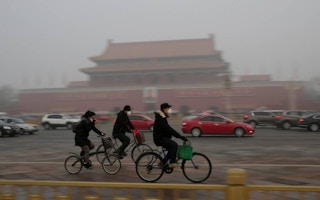The world is on track to see “terrifying” climate impacts as stepped-up emissions-cutting plans filed by countries so far fail to limit fast-accelerating global warming, analysts said on Wednesday.
More than two-thirds of about 195 countries that signed the 2015 Paris climate accord submitted a new or updated climate action plan by an extended UN deadline on Tuesday, a tracker by the US-based World Resources Institute (WRI) shows.
That is an increase from the just over half of countries who filed plans by the end of July. Nations that updated their pledges in recent days include South Africa and Japan, with the latter promising to halve its emissions by 2030 from 2013 levels.
But other major emitters including China, India, Turkey and Saudi Arabia - which produce around a third of global emissions — have yet to strengthen their targets despite pressure growing on them to do so before the UN’s COP26 climate summit.
“They should do so as soon as possible before the COP and developed countries should rapidly step up their climate finance,” said Claire Fyson, a climate policy expert at Climate Analytics, a Berlin-headquartered non-profit.
Fyson said current emissions-cutting pledges and net-zero commitments put the world on a trajectory to 2.4 degree Celsius of warming by the end of the century.
“This is terrifying considering the impacts we are already experiencing at 1.1C,” she told the Thomson Reuters Foundation.
Analysts say securing more ambitious emissions-cutting plans and providing the finance to put them into practice are crucial at COP26, due to take place in Scotland from Oct. 31-Nov. 12.
The conference has been billed as the last chance to galvanise the collective effort needed to limit global warming to 1.5C above pre-industrial times, the more ambitious goal of the international Paris Agreement on climate change.
Meeting the 1.5C target will not prevent extreme weather worsening or sea levels rising, but it is seen as vital for avoiding runaway impacts on humans and the planet, including larger-scale hunger and migration.
China, India gap?
Green groups have said deeper emission cuts from the world’s 20 largest economies, or the G20, would be particular crucial to keep the 1.5C goal within reach and those countries must come up with more ambitious targets before the COP26 summit.
“China’s emissions gap for 2030 — 25 per cent of the total global gap to be on track for 1.5C — means that China in particular needs to take important steps forward,” said David Waskow, the director of WRI’s International Climate Initiative.
India, which has yet to set a target year to achieve net-zero emissions, has said it has been slashing emissions and adding renewables to its energy mix, but any further commitment will depend on finance from rich countries.
The UN’s climate science panel has said planet-heating emissions need to fall by 45 per cent from 2010 levels by 2030, and then hit net-zero by mid-century, to have a good chance of keeping warming to 1.5C.
A 25 per cent reduction is needed this decade to limit planetary heating to 2C, the higher ceiling in the Paris Agreement.
But a September report by the UN climate change body, which assessed climate action plans from 113 countries that filed by a July deadline, said those commitments would bring greenhouse gas emissions down by only 12 per cent by 2030.
“The ambitions reflected in the updated (plans), particularly those of major emitters, do not put the world on track for the goal of limiting warming to 1.5C,” said Illari Aragon, a climate researcher at the International Institute for Environment and Development, a London-based research group.
“Recent catastrophic floods and wildfires remind us that the impacts of climate change are already being felt across the world but lower-income countries have fewer resources to help them cope,” she added.
Efforts to transition to a low-carbon society need to be fair and just, as many developing nations still struggle to provide basic services like electricity, said climate advocate Harjeet Singh.
“Even if all countries have set a target, it’s not equitable,” said Singh, a senior advisor at Climate Action Network International, a network of more than 1,500 groups.
“Rich countries should achieve (net-zero) by 2030. They have enjoyed the fruits of development, they’ve got the resources. But here we are looking at the same target and expecting developing countries to also reach the same finish line at the same time.
“This is not going to happen practically,” he added, calling for technology and finance support to aid further emissions cuts.
This story was published with permission from Thomson Reuters Foundation, the charitable arm of Thomson Reuters, that covers humanitarian news, climate change, resilience, women’s rights, trafficking and property rights. Visit http://news.trust.org/climate.










